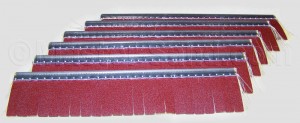Our Made in USA sanding brushes are designed to replace QuickWood™, Flex-Trim™, Pro-Flex, and Slipcon, in addition to being original equipment in Master-Sand™ heads. Our abrasives are laser-cut, not die cut, giving you consistent quality with no break-in period. It’s simple to switch to a better system. You will see the longest life possible and the best value for your dollar by using the Master-Sand™ system. In fact, our sanding brushes can be found as original equipment and preferred replacements on some of the world’s finest brush sanding machinery.
When choosing the proper sanding brush, several factors must be taken into account. Every application is different, and each application requires a certain brush. Because of this, you will not find a standard “catalog” published by us. We supply each customer with the solution they need. Please contact us for your quote.
The factors to consider when choosing a sanding brush are:
- Type of job.Brush sanding is an extremely effective method of coarse sanding as well as super-fine sealer sanding.
- Working on bare wood. When working on bare wood, one needs to consider the species of the workpiece. Dense hardwoods like oak, maple, hickory, etc. will react differently to each abrasive grit when compared to softer hardwoods like alder, or whitewoods. Also consider the stage in production and the results you want. Do you need to remove knife marks left from your moulder, do you need to prepare the workpiece for finishing?
- Primer/Sealer sanding. You must consider the type of finish used. Hard coatings will require different brushes than softer coatings, for one.
- Depth of profile. Brush sanding can be used to sand anything from a flat MDF panel to the most detailed linear moldings and entry doors. In general, the deeper the profile, the higher the trim length of your sanding brushes. Do not “overshoot” the trim length. Although a high sanding brush might work well on a 3” thick grand entrance, it will not perform nearly as well on a flatter surface.
- Detail of profile. We account for the detail of your profile by using various sizes of flaps cut into the sandpaper. Typically a brush sanding head will have several different flap sizes so that all areas of your workpiece will be sanded effectively.
General Recommendations for Abrasives
We stock the following abrasives at all times:
| Aluminum Oxide Deerfos JA165 (reddish-brown in color) Spec Sheet (39K, PDF) |
|||
| Recommended Use | |||
| Grit (P) | Removing knife marks |
Final prefinish |
Sealer Sanding/ de-nibbing |
| 60 | X | ||
| 80 | X | ||
| 100 | X | ||
| 120 | X | ||
| 150 | X | ||
| 180 | X | ||
| 280 | X | ||
| Silicon Carbide Deerfos KC237 (black in color) Spec Sheet (38K, PDF) |
|||
| Recommended Use | |||
| Grit (P) | Removing knife marks |
Final prefinish |
Sealer Sanding/ de-nibbing |
| 180 | X | ||
| 220 | X | X | |
| 240 | X | X | |
| 320 | X | ||
| 400 | X | ||
| Aluminum Oxide Cora KF376 (green in color) Spec Sheet (45K, PDF) |
|||
| Recommended Use | |||
| Grit (P) | Removing knife marks |
Final prefinish |
Sealer Sanding/ de-nibbing |
| 100 | X | ||
| 120 | X | ||
| 150 | X | ||
General Recommendations for Brush Height
General Recommendations for Flap Width
Master-Sand supplies four “standard” flap sizes:
- 4 mm wide flaps are used on many sanding heads (together with 7 mm flaps) to sand most details in typical profiles.
- 7 mm wide flaps are used on many sanding heads (together with 4 mm flaps) to “float” over the high spots and less-detailed sections of typical profiles.
- 20 mm wide flaps are used on flat or nearly-flat surfaces to provide aggressive sanding action.
- Sanding strips with no flaps (0 mm) are used to sand surfaces with no detail.
Our laser cutting method allows us the flexibility to supply any flap size you need. If you don’t see it here, please ask; we’ll be more than happy to work with you.
Copyright notice: Specification sheets are included for your reference, and are current as of February 2010. Those for JA165 and KC237 materials copyright Deerfos. Specification sheet for KF376 copyright Saint-Gobain Abrasives. All rights reserved by the original copyright owners.

